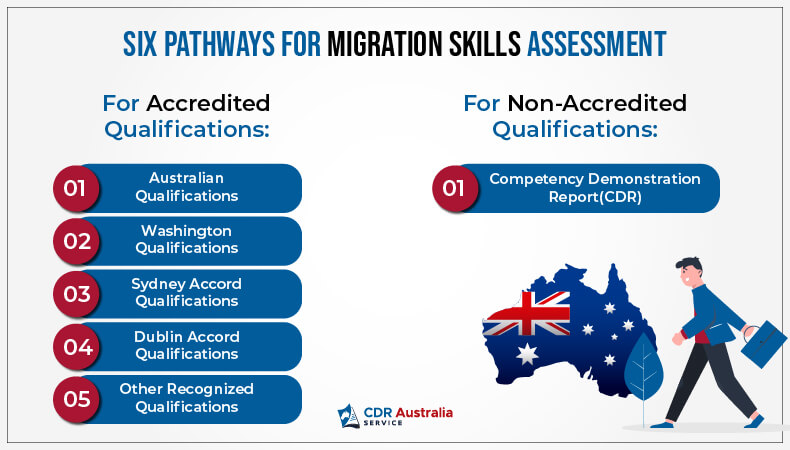Six pathways for Migration Skills Assessment

Six pathways for Migration Skills Assessment
Engineering professionals who intend to go to Australia must perform the EA Migration Skills Assessment procedure. This is a skill assessment of the engineer applicant’s knowledge and competence to validate the eligibility required for the profession at the required level for their chosen occupation in Australia. Those engineers who do not have Australian qualifications or qualifications from nations that have not been associated with the Australian qualifications must pass through the skills assessment process. All the engineers who belong under this segment must go along with the CDR report route.
CDR is short for Competency Demonstration Report, and it demonstrates to Engineers Australia that the engineers have the skills and competencies required for skilled migration to Australia. CDRAustraliaService has a qualified expert team that assists you in preparing a professional CDR report on your demand. We assure you of top-notch and high-quality report services and help you to obtain a positive result from Engineers Australia.
Engineers Australia’s migration skills assessment pathways

If an engineer intends to transmigrate to Australia, accredited qualifications and non-accredited qualifications are the two most common categories for skills assessment pathways. Under these two categories, there are different six qualification pathways. They are:
- Accredited Qualifications:
- Australian Qualifications
- Washington Qualifications
- Sydney Accord Qualifications
- Dublin Accord Qualifications
- Other Recognized Qualifications
- Non-accredited Qualifications:
- Competency Demonstration Report(CDR)
Non-accredited courses are those that are not affiliated with any external accreditation or professional association. You must apply for an Australia Immigration online, selecting the skills evaluation route that corresponds to your membership criteria. Always double-check the status of your qualification’s recognition with the appropriate signatories. Applications that are submitted through the improper route will be rejected. So, you must :
- Choose the Australian qualifications path, if you do have Australian Accredited Qualifications
- Pick the Accord Pathway if you obtain Accord Qualifications
- Select the CDR path if you’ve already completed a Stage-1 evaluation
Accredited Qualifications
Accredited courses are those that have been approved by statutory and professional bodies and have reached the Australian standards. Qualifications obtained in a signatory nation are eligible for recognition under the Accords. The accredited qualifications surpassed Australian criteria and are recognized by official global accords. The accredited credentials are engineering qualifications from Australia and overseas countries that have been acknowledged through official international accords.
Any qualifications acquired in or after the year in which the nation was granted complete member status to the Accords are eligible for accreditation under the Accords. Accredited qualifications lead to the professional qualification you desire or plan to obtain in the sector. With the concise rank and label of your qualification, it can assist you to succeed in your nominated occupation. Engineers can pursue three levels of accreditation: Professional engineers, Engineering associates, and Engineering technologists.
Australian Qualifications
The Australian qualifications structure is developed by the Australian government to guarantee that qualification titles are comparable across the country and reflect the same high educational requirements. Graduates of recognized Australian engineering courses follow the Australian Engineering Qualifications application process for migration skills evaluation for the engineering category of occupations.
The year given after each program is the year in which Engineers Australia initially accredited that program. Students who started their studies within a certain time frame are considered to have completed a recognized program. Once a program has begun, it is sometimes stated as an (F). After the beginning date, provisional accreditation is denoted by a (P), indicating that complete certification is expected but not assured. For the evaluation procedure, candidates with Provisional certification must deliver a competency demonstration report.
The applicants with recognized Australian credentials completed outside of Australia must provide IELTS, TOEFL, or PTE ACADEMIC test scores.
Washington Qualifications
The Washington qualifications permit only publicly mentioned qualifications as recognized by the applicable signatory for recognition. The title of your qualification should match the title on the appropriate signatory’s public list of authorized qualifications. Qualifications achieved in or after the year in which the appropriate institution achieved complete signatory authority to the Washington Accord are qualified for authorization. For this pathway, provisional accreditation is insufficient for assessment.
The least academic criteria for a Washington Accord assessment are qualifications that are roughly equivalent to an Australian four-year bachelor’s degree in engineering.
Sydney Qualifications
The Sydney qualifications accept the only publicly listed qualifications as relevant by the recognized signatory for recognition. The title of your qualification and the title on the public list of certified degrees must be the same for the corresponding signatory. Qualifications achieved in or after the year in which the appropriate institution achieved entire signatory authority to the Sydney Accord are eligible for accreditation. For this pathway, provisional accreditation is insufficient for assessment.
The Sydney Accord’s minimal education requirements involve degrees that are roughly correspondent to an Australian three-year undergraduate qualification of technology in engineering.
The Dublin Qualifications
The Dublin qualifications consider the only publicly mentioned qualifications as approved by the appropriate signatory for recognition. For the authorized body, the title of your qualification and label of degrees mentioned on the public must be the same for the relevant signatory. The applicant must have completed their studies in or after the year when the relevant institution became a full signatory to the Dublin Accord. Provisional certifications are inadequate for assessment in this pathway.
Only engineering qualifications approved by the signatory country’s authorized authority are recognized by the Dublin Accord.
Other Recognized Qualifications
Engineers Australia and the French authority des Titres d’Ingénieurs have established a treaty to build it easier for French engineering degrees to be established in Australia.
It follows up with holders of a French Diplôme d’Ingénieur accomplished in or after 1970 and listed in the Journal Officiel de la République’s list of institutions habilitated to provide the title of Engineer for the year of completion are eligible for an evaluation through the approved qualifications pathway.
Checklists for Accredited qualifications pathway
The essential documents required for skill assessment in the accredited qualification pathways are:
- Recent passport size color image
- Identity documents such as birth certificate, passport
- CV/Resume
- Educational documents
- Academic transcripts and certificates
- Name change documents(if applicable)
- English proficiency test score i.e. IELTS, PTE,TOEFL
Non-accredited Qualifications
Non-accredited courses are those that are not affiliated with any external accreditation or professional association. These programs are fantastic for acquiring a new skill set or improving your current capabilities. The purpose of non-accredited courses is to provide students with a certain range of skills and expertise, and they will bring value to your resume.
Non-certified qualifications do not lead to pursuing a professional career with relevant qualifications behind your name; instead, accredited qualifications are required. The other nations that have not been certified by Engineers Australia(EA) must present a Competency Demonstration Report(CDR) to EA for migration skills evaluation.
Competency Demonstration Report(CDR)
The engineers who have holds accredited qualifications and want to migrate to Australia, need to prepare and present CDR to EA. The CDR demonstrates the skills and qualifications of the engineer in the related engineering field to fulfill the Australian migration visa standard. The documentation proofs of essential technical expertise supporting the chosen occupation and verified ability to apply knowledge in the chosen field must be included in the CDR report. The essential documents that must be encompassed in a professional CDR are Continuous Professional Development, Summary Statements, and three Career Episodes.
All the engineers require to provide the CDR report by Engineers Australia for the migration skill assessment process. Engineers Australia assesses and validates the skills and qualifications of the applicants in the engineering field through the CDR report. EA verifies the CDR very closely and precisely, so the possible outcome is based on the quality of the provided CDR by applicants.
Before writing a CDR, there are several factors to consider. The applicants should analyze the “Migration Skills Assessment(MSA)” booklet precisely provided by EA, and the guidelines and instructions should stick to the letter.
If you have trouble preparing a perfect CDR report, CDRAustraliaService provides highly qualified expert guidance to you in preparing a professional CDR. We also provide CDR samples for engineers, which can be utilized as a reference.
Checklists for non-accredited pathway
The applicant must deliver the following documents in the CDR report are as follows:
- Most recent passport size image
- Updated CV/Resume
- Identification documents such as passports, birth certificates
- Qualification documents
- Academic transcript and awards
- Name change evidence(if applicable)
- English proficiency test score i.e. IELTS, PTE,TOEFL
- Employment reference evidence
- Paid employment proofs(payments slips, tax paid)
- Continuous professional development, summary statements, and three career episodes
Conclusion
The engineer with different qualifications that can be certified and non-certified qualifications have five different qualification pathways for migration skill assessment for Australia. The applicants should choose the appropriate pathway corresponding to their qualifications which are already explained above. The applicants with these two qualifications can go through with four alternatives and CDR respectively.
CDRAustraliaService has a team of experienced and certified experts, who assist you in preparing your professional CDR report. We also deliver high-quality CDR writing and review services, 100% plagiarism-free reports, individual tutoring, and many other quality services.



 Talk With Us
Talk With Us